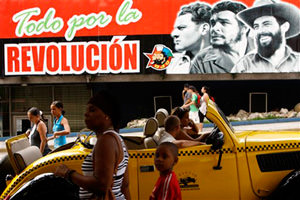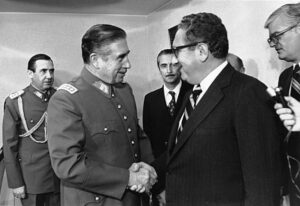Cuba by the Numbers
Fidel Castro recently told The Atlantic that the Cuban model does not work anymore, not even for Cuba. But according to statistics collected by none other than the CIA, the Cuban model has actually worked very well. Fidel Castro recently said the Cuban model does not work anymore, but according to CIA statistics, it has actually worked very well.
Fidel Castro recently told The Atlantic that the Cuban model does not work anymore, not even for Cuba. But according to statistics collected by none other than the CIA, the Cuban model has actually worked very well.
Cubans do much better than the citizens of all their neighboring Caribbean and Central American states by all kinds of measures. The Cuban government spends much more on education, and a Cuban child therefore can expect to get a much better education, and for several years longer, than a child in any of Cuba’s neighboring countries. A Cuban citizen can expect to live longer. Cuba’s GDP per capita is higher than it is in seven of its nine neighbors. Cuban workers also fare better than their brethren in the U.S. because, while the GDP per capita in the U.S. is significantly higher, Cubans, until this month, have enjoyed universal job security and virtually no unemployment. How can Castro and the CIA see things so differently? (Countries with fewer than 350,000 people were excluded from the table below.)
| Population | Un- employment rate 2009 |
Life Expectancy | School Life Expectancy | Education Expenditure % of GDP | GDP Per Capita | |
| Guatemala | 13,276,517 | 3.2% (2005) | 70.3 | 10 | 2.6% | $5,100 |
| Cuba | 11,451,652 | 1.7% | 77.45 | 16 | 9.1% | $9,700 |
| Dominican Republic | 9,650,054 | 15.0% | 73.7 | 12 | 3.6% | $8,300 |
| Haiti | 9,035,536 | N/A | 60.78 | N/A | 1.4% | $1,300 |
| Honduras | 7,833,696 | 3.0% | 70.45 | 11 | 3.8% | $4,100 |
| El Salvador | 7,185,218 | 7.2% | 72.3 | 12 | 3.1% | $7,200 |
| Nicaragua | 5,891,199 | 8.2% | 71.5 | 11 | 3.1% | $2,800 |
| Costa Rica | 4,253,877 | 7.8% | 74.96 | 12 | 4.9% | $10,900 |
| Panama | 3,360,474 | 7.0% | 77.25 | 13 | 3.8% | $12,100 |
| Jamaica | 2,825,928 | 12.9% | 73.53 | 12 | 5.3% | $8,400 |
| USA | 307,212,123 | 9.3% | 78.11 | 16 | 5.3% | $46,000 |
| Source: CIA World Factbook. | ||||||
Castro and the CIA have vastly different perspectives. While the CIA’s task is to gauge the well-being of ordinary citizens in any given country, it appears that Castro and the Cuban leadership have been lending their ears to the complaints of the Cuban managerial class. Earlier in September, Cuba announced that half a million workers in its economy are redundant and would be offered alternative jobs in different occupations. If they refuse to accept these they will be fired, and they will have to find employment in the private sector. Unemployment benefits will be limited to three months.
Half a million workers constitute about 10 percent of the Cuban labor force, a percentage figure roughly equal to the rate of unemployment in the U.S. Thus, if these workers are indeed redundant, then Cuba’s unemployment rate is the same as the rate that currently prevails in the U.S., with one key difference. In Cuba these workers go to work every day and earn full pay and they and their families enjoy all the material and psychological benefits that come from being employed with a steady pay check. Is it really better to inflict on these workers the fate of unemployed workers in the U.S.? Apparently Cuban managers think so.
The first indication that Cuba was starting to shift to a managerial worldview came in 2008, when Raul Castro announced the end of egalitarian pay and its replacement with “productivity”-based pay. Because production is carried out by teams, measuring the productivity of each worker or manager is impossible. (See “Is Cuba Done With Equality?”) What productivity-based pay really means is high pay for managers and low pay for workers. But why would workers agree to such a division of the products that their teams have produced if they have job security and a guaranteed right to work? Better to make them thankful to have a job, which is precisely what the mass firing of workers in Cuba will accomplish. The directive from the government to managers is to fire workers who are unproductive or whose pay is higher than their productivity. In other words, worker, you owe your job and pay to your manager.
The Cuban government has shifted to the managerial worldview, and so have American newspapers. Both The New York Times and The Washington Post accompanied their news articles about this shift with photographs of Cuban taxi drivers hanging out or sleeping, as if this is what most Cuban workers do.
According to the CIA, 19 percent of Cubans work in industry, while according to the Bureau of Labor Statistics, in the U.S. this rate is only 17 percent. The biggest difference in employment between the countries is in agriculture and in the occupations of workers who provide services. Cuban agriculture is less mechanized, and therefore 20 percent of Cubans work in agriculture, whereas in the U.S. the share of agricultural workers is only 1 percent. And there is no doubt that some workers who in the U.S. would have worked for Wall Street or law firms are doctors or health care workers in Cuba. Cuba has made medical care one of its most important export industries. In fact, Cuba pays for its oil by sending medical personnel to take care of Venezuela’s poor. Cuban medical personnel are also known for their work in Africa.
The ascendancy of the managerial class that has swept the rest of the world since President Ronald Reagan assumed office has finally reached Cuba. What to do about it is a question that the whole world now must grapple with.
This article is based on Moshe Adler’s book, “Economics for the Rest of Us: Debunking the Science that Makes Life Dismal,” 2010, The New Press.
Your support matters…Independent journalism is under threat and overshadowed by heavily funded mainstream media.
You can help level the playing field. Become a member.
Your tax-deductible contribution keeps us digging beneath the headlines to give you thought-provoking, investigative reporting and analysis that unearths what's really happening- without compromise.
Give today to support our courageous, independent journalists.









You need to be a supporter to comment.
There are currently no responses to this article.
Be the first to respond.